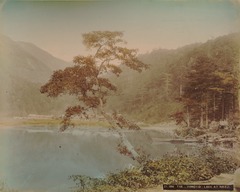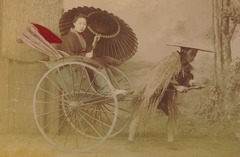Top Qs
Timeline
Chat
Perspective
Kusakabe Kimbei
Japanese photographer (1841–1934) From Wikipedia, the free encyclopedia
Remove ads
Kusakabe Kimbei (日下部 金兵衛; 1841–1934) was a Japanese photographer. He usually went by his given name, Kimbei, because his clientele, mostly non-Japanese-speaking foreign residents and visitors, found it easier to pronounce than his family name.[3]: 8
Remove ads
Career
Kusakabe Kimbei worked with Felice Beato and Baron Raimund von Stillfried as a photographic colourist and assistant. In 1881, Kimbei opened his own workshop in Yokohama, in the Benten-dōri quarter.[3] From 1889, the studio operated in the Honmachi quarter.[4]
By 1893, his was one of the leading Japanese studios supplying art to Western customers.[5] Many of the photographs in the studio's catalogue featured depictions of Japanese women, which were popular with tourists of the time.[5]: 10 Kimbei preferred to portray female subjects in a traditional bijinga style, and hired geisha to pose for the photographs.[6] Many of his albums are mounted in accordion fashion.[7][8]
Around 1885, Kimbei acquired the negatives of Felice Beato and of Stillfried, as well as those of Uchida Kuichi.[4] Kusakabe also acquired some of Ueno Hikoma's negatives of Nagasaki.
Kimbei retired as a photographer in 1914.[9]
Remove ads
Gallery
- Country children
- Kago Travelling Chair
- Wringing the Tealeaves on the Furnace
- Writing Letter (also known as Letter Writer)
- Yumoto lake at Nikkō, Tochigi (日光市), Japan
- Buddha statue at Hakone, Japan
- Bell of Daibutsu in Kyoto
- Japanese woman in jinrikisha
- View of Mount Fuji. Hand-coloured albumen silver print, 1880.
- Japanese Lantern Makers
References
Further reading
External links
Wikiwand - on
Seamless Wikipedia browsing. On steroids.
Remove ads











